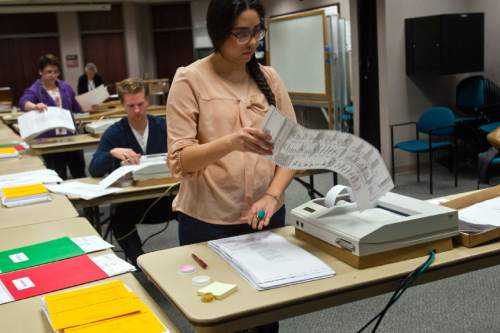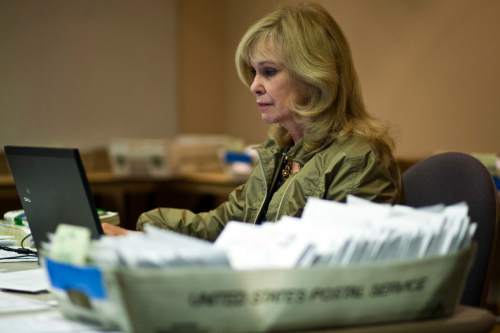This is an archived article that was published on sltrib.com in 2015, and information in the article may be outdated. It is provided only for personal research purposes and may not be reprinted.
With two young kids, it's hard for Holly Smith to go to a polling location on Election Day. If there's a line, she's often pulled between entertaining her 4- and 6-year-olds and being attentive to the issues and candidates.
So for the past six years, the Holladay mom has opted to vote from home using a mail-in ballot.
"It's really convenient because I can take my time," Smith said.
She'll soon be joined by most neighbors and many residents throughout Salt Lake County.
While any individual registered voter can choose to vote by mail, many cities — including Holladay — are making that the standard. Fourteen of the 16 cities in the county have adopted vote-by-mail for municipal elections. The only exceptions are Taylorsville and West Valley City.
Salt Lake County Clerk Sherrie Swensen is a fan of the change, saying it spurs greater participation in elections. Cottonwood Heights, for example, switched to vote-by-mail in 2013 and tripled its voter turnout, she notes.
Six cities — Herriman, Holladay, Midvale, Salt Lake City, South Jordan and South Salt Lake — will all use vote-by-mail for the first time in the Aug. 11 primaries.
Chuck Newton, South Jordan city councilman, hopes the method will allow more residents to vote. He said one-third of the registered voters in South Jordan currently elect to vote by mail, and he hopes 90 to 95 percent will now complete their ballots this way.
"It makes it easy for people to check the box and be done," said Newton, who's running for re-election in District 2, where he has three challengers.
Residents of vote-by-mail cities still have an option to cast a ballot more traditionally, albeit on a touch screen. Election officials will staff a few consolidated polling places.
The number of locations in each city will depend on its population. South Jordan, which just overtook Taylorsville as Utah's 10th most populous city, will have just one polling place for the primary and three for the Nov. 3 final election. Salt Lake City, the state's largest city, will offer four polling places for the November election.
Swensen sees the transition as a win-win. It allows people to vote using the method they prefer and it saves taxpayer money: an estimated $63,000 this year.
Another advantage of vote-by-mail, she said, is saving wear and tear on aging voting machines.
Ballots for municipal primary elections will be sent out July 13 — almost a month in advance of primary Election Day — and should begin appearing in mailboxes soon after. They can be returned anytime before Aug. 11.
In addition to vote-by-mail, most cities also have implemented early voting, which begins July 28 and lasts through Aug. 7. Voters can cast ballots at consolidated polling places during that period.
Holladay's City Council unanimously approved the switch to vote-by-mail late last year, and Mayor Robert Dahle is excited about the upcoming debut.
"The more ballots we get in," he said, "the more representative we think our policies and our council members are."
Ballot return percentages vary by city. In the 2013 Cottonwood Heights municipal election, 38.2 percent of the mail-in ballots were sent back, and 27.2 in West Jordan.
But not everybody is on board with vote-by-mail. Janalee Tobias, a resident and activist in South Jordan, was among about 10 people who voiced concerns about the switch during two South Jordan City Council meetings on the subject, before it was approved on a 4-1 vote.
A big concern for Tobias is patriotism and tradition. Growing up, Tobias' mom took her to a polling center to vote, and Tobias did the same thing with her kids. Now, she's worried residents will miss what is for her a key component of American elections.
"Voting is our most cherished right," she said. "The ballot box is crucial to preserving freedom."
Tobias also fears voting by mail creates more opportunity for voter fraud. Her ballot could be stolen or forged or lost in the mail, she said.
But Swensen believes that "scare concern" is unfounded.
"No one is going to be able to run up and down the streets and take ballots out of somebody's mailbox and have us count them," she said.
Each vote-by-mail ballot comes in a special envelope. When a resident completes it, he or she seals it, signs a flap and then also seals that down. To confirm the vote, Swensen's team at the county clerk's office opens just the signature portion and compares it to the resident's signature on file. If the two don't match, the voter is sent an exception letter to confirm if they actually voted.
The two cities who opted against vote-by-mail —Taylorsville and West Valley City — have their reasons. But both will still have consolidated polling centers come Election Day, and registered voters who request a mail ballot before Aug. 6 can still get one.
The Taylorsville City Council approved vote-by-mail 3-2, but Mayor Larry Johnson vetoed the measure. He said in a statement that the traditional method of voting provides "residents with the most options to participate in the voting process."
Currently, one-third of Taylorsville residents opt for mail-in ballots, and Johnson doesn't want to "restrict" access to polls for the majority of voters in the city. The council plans to reconsider the measure at a later date.
West Valley City Mayor Ron Bigelow said the system can be confusing. With city and countywide elections switching off every year, residents would vote by mail one year and then have to go to a polling location the next year because the vote-by-mail system is currently just for individual municipalities, not all of Salt Lake County. He said residents "didn't want to switch back and forth" between the two methods.
Swensen said she might suggest to the Salt Lake County Council extending vote-by-mail to the entire county to avoid that problem, as Davis, Duchesne and other counties have done. But she first plans to use this year's election year as an experiment in voter turnout.
"We're going to look at how well it's received," she said. "If it's a higher turnout and people are receptive and like it, then it might be something that we propose."
Twitter: @CourtneyLTanner





